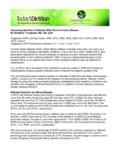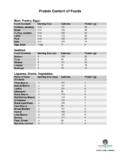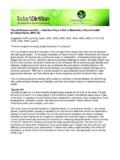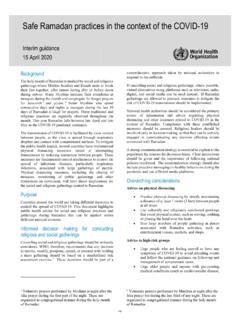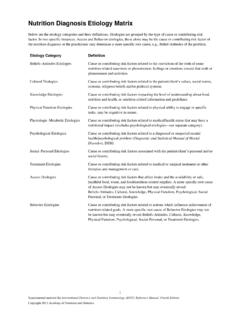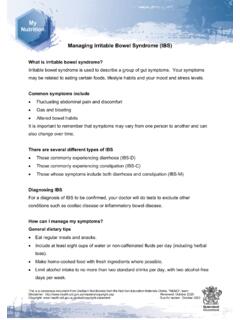Transcription of Assessing Nutrition in Patients With ... - Today's Dietitian
1 Assessing Nutrition in Patients with Chronic Kidney Disease By Kimberly Thompson, MS, RD, LDN Suggested CDR Learning Codes: 3000, 3010, 3060, 3090, 5000, 5010, 5340, 5390, 5400, 5410; Level 2 Suggested CDR Performance Indicators: , , , Chronic kidney disease (CKD), which affects millions of people every year, can occur as a result of various diseases and health conditions. It also can occur when Patients fail to take prescribed medications for chronic diseases or because of a poor financial situation that prevents Patients from seeking treatment.
2 Often, it can go undiagnosed because of poor medical follow-up by Patients who have chronic medical conditions such as diabetes or hypertension. It is the RD s role to be aware of the underlying cause of a patient s CKD and develop an individualized, evidence-based nutritional plan to improve the patient s quality of life. This continuing education course presents an overview of CKD and end-stage renal disease (ESRD), focusing on the causes of the disease and individualizing clients medical Nutrition therapy by using the evidence-based guidelines established by the Academy of Nutrition and Dietetics (the Academy) and the National Kidney Foundation s Kidney Disease Outcomes Quality Initiative (KDOQI).
3 National Statistics on Kidney Disease In 2010, the National Kidney and Urologic Diseases Information Clearinghouse reported that more than 20 million Americans aged 20 and older had CKD. In 2009, the clearinghouse reported that more than 871,000 people were being treated for ESRD, more than 90,000 of whom died. The estimated cost for such treatment in 2009 was more than $42 billion. The survival rates for Patients with ESRD (all treatment modalities) at one, five, and 10 years were , , and , Every year the US Renal Data System collects data on Patients with ESRD.
4 According to its records, in 2009, there was a increase in the treatment of ESRD by hemodialysis, peritoneal dialysis, transplants, and other From 2008 to 2009, the incidence of ESRD among Asians, African Americans, Native Americans, and Caucasians increased by , , , and , Also during that year, the percentage of ESRD Patients with a primary diagnosis of diabetes increased by ; the percentage with glomerularnephritis increased by ; and the percentage with hypertension increased by However, the percentage of Patients with a primary diagnosis of polycystic kidney disease decreased by Thus, RDs need to pay particular attention to the follow-up and ongoing nutritional care of their Asian and Native American Patients as well as those with poorly controlled diabetes, glomerularnephritis, and hypertension to improve five- and 10-year mortality rates.
5 Kidney Function and CKD RDs can help slow the progression of CKD by managing a patient s diet to reduce protein intake and by managing underlying health conditions such as diabetes, hypertension, and HIV. Because protein intake increases renal blood flow and glomerular filtration rates (GFRs), it s important to decrease protein intake to help maintain lower blood flow and thereby reduce kidney To help their Patients , RDs need to know the kidney s role, the five stages of CKD, and how the disease affects kidney function.
6 The kidneys are essential to life through three functions: excretory, endocrine, and metabolic. Excretory function: The kidneys regulate total body water equilibrium by maintaining the inorganic-ion balance and by excreting metabolic wastes and foreign chemicals; they maintain this balance by producing urea and allowing the body to eliminate Besides regulating water homeostasis, the kidneys, during prolonged states of starvation or fasting, use lactate, pyruvate, amino acids, glycerol, free fatty acids, and beta-hydroxybutyrate to synthesize up to 45% of new energy in the form of glucose.
7 Endocrine function: The kidneys manage various endocrine responses that regulate blood pressure, bone metabolism, and the production of red blood cells. Additionally, when someone develops hypotension, the kidneys secrete the hormone renin, which helps convert angiotensinogen to angiotensin II, a potent vasoconstrictor that brings blood pressure back to normal. The kidneys also produce erythropoietin, which the bone marrow uses to produce the red blood cells needed to deliver oxygen to vital Metabolic function: The kidneys produce active vitamin D3, which promotes calcium uptake in the small intestine and acts as an essential substrate for bone remodeling and Five Stages of CKD There is no cure for CKD.
8 RDs should know how the disease progresses from one stage to the next and be able to identify what stage a patient is in to develop an individualized Nutrition Stages 1 and 2: Kidney disease is relatively unrecognized in stages 1 and 2 because there typically are no symptoms. Stages 1 and 2 generally are diagnosed when there is increased creatinine or urea in the blood, blood and/or protein in the urine, a family history of polycystic kidney disease, or evidence of kidney damage on radiologic Stage 3: As Patients progress to stage 3, they will experience uremia, anemia, high blood pressure, and slight metabolic bone disorders.
9 These disturbances will lead to fatigue, fluid accumulation, decreased urine output, sleep disturbances, and kidney Stage 4: As Patients progress to stage 4, uremia, anemia, high blood pressure, and bone disorders become more prominent. The disturbances seen in stage 3 worsen and lead to additional complications of nausea, changes in taste, uremic breath, decreased appetite, neuropathy problems, and mental concentration issues. At this stage, Patients develop uremia because of the endocrine and metabolic changes that occur.
10 Later, Patients develop osteodystrophy, anemia, oxidative stress that leads to heart and vascular diseases, impaired immune function, and protein energy malnutrition as a result of inflammation from oxidative and carbonyl stressors. Patients in stage 4 might complain of weakness, malaise, poor sleeping habits, fatigue, and loss of appetite caused by an increased amount of waste products in the blood. These waste products can lead to gastrointestinal disturbances that can result in poor food consumption, which in turn cause weight loss and the symptoms described Patients at this stage will be referred to a nephrologist for quarterly medical appointments to track disease progression.

